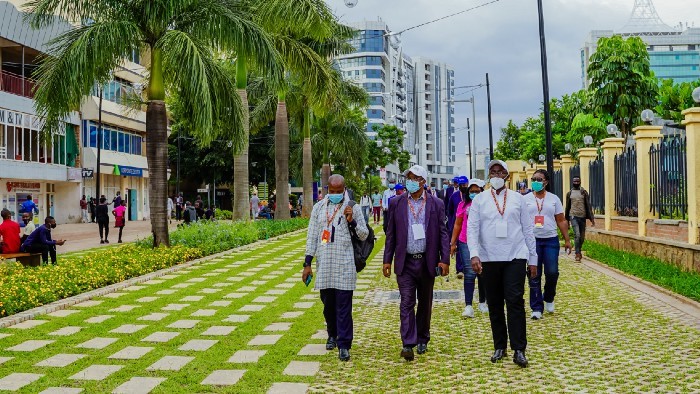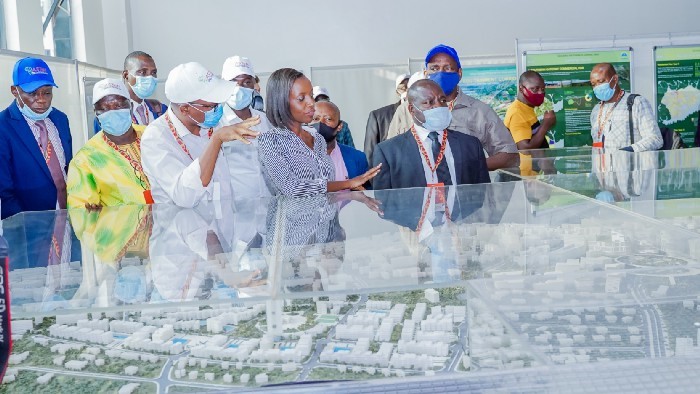Kigali’s citizen centred vision for digital transformation
In November 2021, the ASToN network travelled to Kigali for ASToN City Week. This network brings together representatives from 11 African cities working on digital projects to create sustainable and inclusive cities.
One of the aims of the network is to enable the cities to learn from one another. Throughout the Covid-19 pandemic, the ASToN network has been doing this by meeting regularly online. Now, for the first time in two years, we had the opportunity to meet in person in Kigali, Rwanda. This event allowed participants to see, first-hand, how Kigali is approaching digital transformation.
Over the course of the week we heard from the Mayor of Kigali, the Ministry of ICT and Innovation, and various partners and start-ups involved in Kigali’s digital development and transformation of government services. The progress made in the last 10 years is striking, and has been led by the ambition to embrace digital tools and put all citizen services online, which they hope to achieve over the next few years. The city wants to do this to ensure that services are more citizen-centered, reach them more easily, and are more efficient to run.
4G now extends across 95% of the country, and Rwandans can now access over 100 government services online. Buses accept cashless payment and free WIFI is provided in public spaces such as the new pedestrianised street in Kigali city centre.

After a dazzling presentation from Alice Higiro, Programme Director at the Ministry of ICT and Innovation, the members of the ASToN network had many questions.
How have citizens responded to these services aiming to improve their lives?
How are you financing all these projects?
What challenges did you encounter, and what were the ingredients of success?
Here are the 4 key messages we’ve drawn from Kigali’s experience:
1. Keep the citizen at the centre
The message from our speaker was loud and clear: the most vital ingredient of success is to focus on what citizens need. Focus on ensuring they have a good experience rather than the more top-down view of what the governmentneeds, she said: “If you work on projects that serve the government only, it’ll get stuck somewhere.”
The Ministry conducted research to understand the point of view of citizens, their main points, and build a picture of how technology might be used to address these. Through regular surveys, they invite citizens to provide input, which helps the government to prioritise, build services that work, and get buy-in for new projects too. Most recently, the City of Kigali is creating a citizen portal using a French application called Tell My City, giving citizens a direct line to the local authority.
The mantra “zero trips, zero paper” demonstrates the commitment to supporting citizens to access services without time wasted travelling, and without unnecessary paperwork. Importantly, while there is a clear push for the use of digital services, those who don’t have phones or data can also access the new services via agents positioned across the country.
2. Establish a clear and unifying vision
A single vision can bring together different layers of government, and effectively enroll the local and grassroot levels. This allows everyone to understand the role they play in delivery change. In Rwanda, the national government set out their vision in the Master Plan 2020, and more recently the Master Plan 2050.

These plans set up frameworks and shared performance indicators that allow the many departments of government to push in the same direction. Chief digital officers were established to manage projects at different levels of government, ensuring coherence and consistency.
3. Explore a mix of financing models
Financing is a key concern for the cities in the ASToN network and our speaker encouraged us to explore many different ways of financing this work. For Rwanda, this has included some blended financing from the government, World Bank, Smart Africa Alliance and more.
In other cases, digital projects auto-finance thanks to public-private partnerships. Irembo is the government’s single online portal — developed and managed for the government by a private partner using a ‘Build-Operate-Transfer’ contract. They work hand in hand with government instiutions to develop digital services: from getting a passport, to booking a visit to the Genocide Museum. Irembo/the company takes a percentage of the revenue collected, meaning they operate with shared incentives for successful and efficient transactions.
4. Believe in your private sector
Our speaker urged the ASToN delegation to empower the youth and the private sector to develop solutions and work closely with the government. This means being very clear about what problems the government is focused on, and inviting the private sector to find ways to solve them.
For example, Tap&Go is a Rwandan start-up that developed the cashless payment system now available in buses across Kigali. Part of the success of Tap&Go comes from the closeness of AC Group, the company behind Tap&Go, to the urban issues of Kigali. The company is now looking to scale up its product to other countries, including Cameroon.
Written by Alice Carter.


